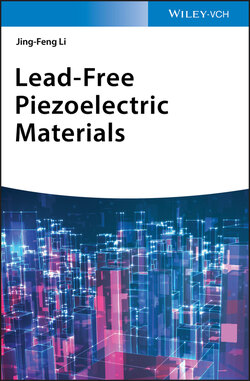Lead-Free Piezoelectric Materials

Реклама. ООО «ЛитРес», ИНН: 7719571260.
Оглавление
Jing-Feng Li. Lead-Free Piezoelectric Materials
Table of Contents
List of Tables
List of Illustrations
Guide
Pages
Lead‐free Piezoelectric Materials
About the Author
Foreword by Professor Longtu Li
Foreword by Professor Jürgen Rödel
Preface
1 Fundamentals of Piezoelectricity. 1.1 Introduction
1.2 Piezoelectric Effects and Related Equations
1.3 Ferroelectric Properties and Its Contribution to Piezoelectricity
1.4 Piezoelectric Parameters. 1.4.1 Piezoelectric Constants. 1.4.1.1 Piezoelectric Charge (Strain) Constant
1.4.1.2 Piezoelectric Voltage Coefficient (G‐constant)
1.4.2 Piezoelectric Coupling Coefficient
1.4.3 Mechanical Quality Factor
1.5 Issues for Measuring Piezoelectric Properties. 1.5.1 Measurement of Direct Piezoelectric Coefficient Using the Berlincourt Method
1.5.2 Measurement of Converse Piezoelectric Coefficient by Laser Interferometer
1.5.3 Resonance and Anti‐resonance Method
References
2 High‐Performance Lead‐Free Piezoelectrics. 2.1 Introduction
2.2 BaTiO3
2.3 (K,Na)NbO3
2.4 (Bi1/2Na1/2)TiO3
2.5 BiFeO3
2.6 Summary
References
3 (K,Na)NbO3 System. 3.1 Introduction of (K,Na)NbO3. 3.1.1 History of (K,Na)NbO3
3.1.2 Crystal Structure and Phase Diagram
3.1.3 Current Development of KNN‐Based Materials
3.2 Synthesis
3.2.1 Calcination
3.2.2 Sintering
3.2.2.1 Normal Sintering
3.2.2.2 Hot Pressing, Spark Plasma Sintering, and Microwave Sintering
3.2.3 Texturing
3.3 Approaches to Piezoelectricity Enhancement
3.3.1 Phase Engineering. 3.3.1.1 O–T Phase Boundary
3.3.1.2 R–T Phase Boundary
3.3.2 Thermal Stability
3.3.3 Multiscale Heterogeneity
3.3.4 Poling Techniques
3.4 Fatigue and Mechanical Properties. 3.4.1 Fatigue
3.4.2 Mechanical Properties
3.5 KNN Thin Films
3.5.1 Sol–Gel‐Processed Films
3.5.2 KNN Films Prepared by Physical Methods
3.6 Single Crystals
3.7 Summary
References
4 (Bi1/2Na1/2)TiO3 System. 4.1 Introduction of BNT System
4.2 Extensive Research on Phase Diagram of (Bi1/2Na1/2)TiO3–BaTiO3 System. 4.2.1 Relaxor or Antiferroelectric?
4.2.2 MPB and Complex Phase Structure
4.3 High Converse Piezoelectricity
4.3.1 Electric‐Field‐Induced Phase Transition
4.3.2 Ergodic and Nonergodic Relaxor
4.3.3 Modulation of Depolarization Temperature
4.3.3.1 Compositional Modification Approach
4.3.3.2 Composite Approach
4.3.3.3 Stress Approach
4.4 Thin Films
4.5 Single Crystals
4.6 High‐Power Application
4.7 Summary and Outlook
References
5 BaTiO3 System. 5.1 Brief Introduction of History
5.2 BaTiO3‐Based Ceramics and Single Crystals. 5.2.1 Ceramics
5.2.2 Single Crystal
5.3 BaTiO3‐Based Solid Solution Ceramics
5.3.1 (Ba,Ca)(Ti,Zr)O3
5.3.2 (Ba,Ca)(Ti,Sn)O3
5.3.3 (Ba,Ca)(Ti,Hf)O3
5.4 Piezoelectricity Enhancement. 5.4.1 Phase Engineering
5.4.2 Domain Engineering
5.4.3 Texturing
5.5 Key Issues of Sintering Processes
5.5.1 Li‐containing Sintering Additives
5.5.2 Glass Compositions
5.6 Mechanical Property
5.7 Summary and Outlook
References
6 BiFeO3 System. 6.1 Introduction
6.2 Brief Introduction to Multiferroic Materials
6.3 Multiferroicity of BiFeO3
6.3.1 Ferroelectricity
6.3.2 Antiferromagnetism and Weak Ferromagnetism
6.3.3 Magnetoelectric Coupling. 6.3.3.1 Antiferromagnetic Switching on Electric Field
6.3.3.2 Ferroelectricity on Magnetic Field
6.4 Phase Diagram of BiFeO3. 6.4.1 High Curie Temperature and Processing Issues
6.4.2 Influence of Pressure on Phase Diagram
6.4.3 Thin Film and Strain Effect on Phase Structure
6.5 Dielectric Permittivity, Electrical Conductivity, and Domain Wall Conductivity of BiFeO3
6.5.1 Dielectric Permittivity
6.5.2 Electrical Conductivity and Defects
6.5.3 Domain Wall Conductivity
6.6 Ion Substitutions in BiFeO3
6.6.1 On Ferroelectricity (Pr) and Piezoelectricity (d33)
6.6.2 On Phase Transformation
6.6.3 On Magnetic Properties
6.7 BiFeO3‐Based Solid Solutions
6.7.1 BiFeO3–BaTiO3
6.7.2 Other Solid Solutions
6.8 Application of BiFeO3: Potentials and Status
6.8.1 Ferroelectricity and Electronics
6.8.2 Magnetoelectric Coupling and Spintronics
6.8.3 Domain Wall Based Electronics
6.9 Summary
References
7 Applications. 7.1 Introduction
7.2 Representative Applications of Lead‐Free Piezoelectric Ceramics. 7.2.1 Piezoelectric Multilayer Actuators
7.2.2 KNN‐Based Actuation Structure in Inkjet Printhead
7.2.3 Ultrasonic Transducers
7.2.4 KNN‐Based Knocking Sensors
7.3 Other Potential Applications. 7.3.1 Energy Harvesting
7.3.2 High‐Frequency Medical Imaging Transducers Using 1–3 Composites
7.3.3 High‐Temperature Piezoelectrics and Applications
7.4 Summary and Outlooks
References
Index. a
b
c
d
e
f
g
h
i
k
l
m
n
o
p
q
r
s
t
u
v
w
z
WILEY END USER LICENSE AGREEMENT
Отрывок из книги
Jing‐Feng Li
Jing‐Feng Li is Changjiang scholar distinguished professor of the School of Materials Science and Engineering at Tsinghua University, Beijing, China, and also serves as deputy director of Tsinghua University‐Toyota Research Center. Dr. Li has received master and doctor degrees in materials science and engineering both from Tohoku University (Japan) in 1988 and 1991 and a bachelor of engineering from Huazhong University of Science and Technology, China, in 1984. After temporarily working at Nihon Ceratec Co. Ltd., he was appointed to assistant professor in Tohoku University in 1992 and promoted to associate professor in 1997, then joined Tsinghua University as full professor in 2002. He also served as vice department chair (2005–2012) and vice school dean (2013–2016) of Materials of Materials Science and Engineering Department/School at Tsinghua University.
.....
(1.13)
(1.14)
.....